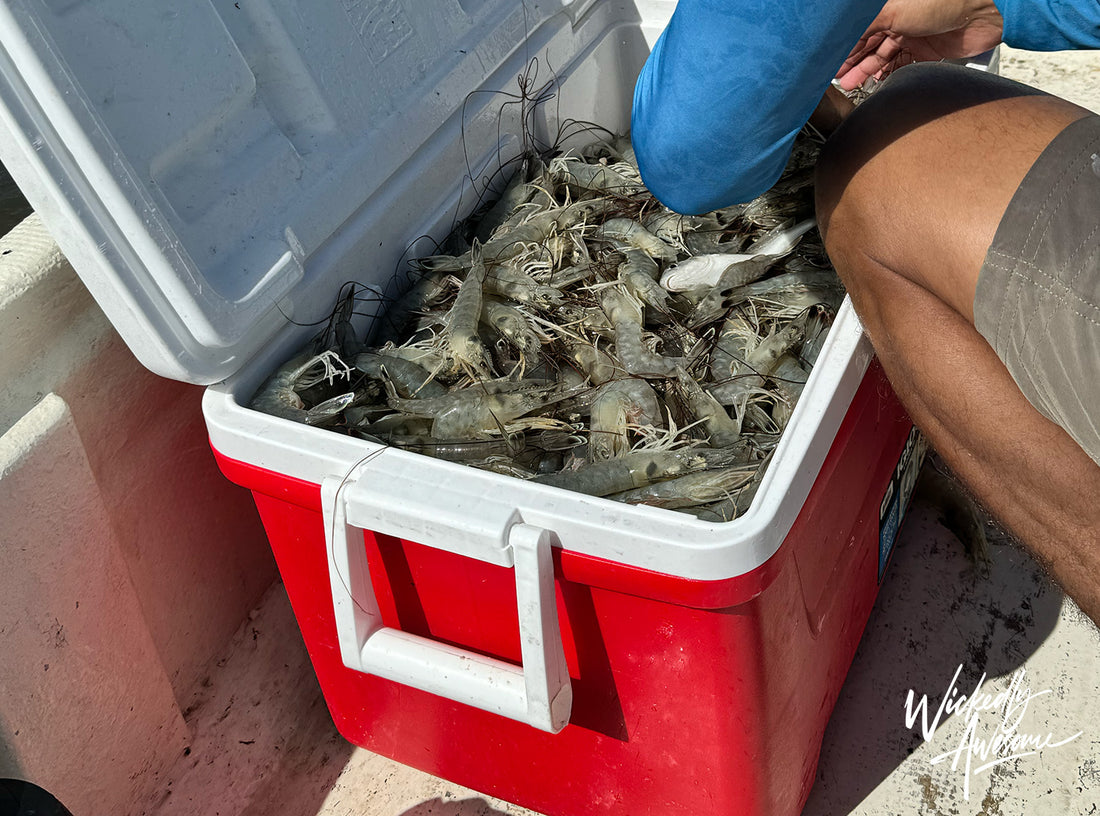Shrimp baiting is an exciting and rewarding way to fish for shrimp. Unlike traditional fishing methods, shrimp baiting utilizes a combination of poles, bait balls, and cast nets to attract and catch these delicious crustaceans. If you're looking to venture into this unique fishing method, here's everything you need to know about shrimp baiting.
Shrimp Baiting: The Basics
At its core, shrimp baiting is about attracting shrimp to a designated location using specially prepared bait, then casting a net over the area to catch them. The bait is typically a mixture of clay and fishmeal, which is molded into balls. These balls are then dropped near poles that are set up in the water, guiding the angler where to cast their net.
The Right Gear for Shrimp Fishing
-
Shrimp Poles: These are essential for marking the spot where you've dropped your bait balls. Typically, anglers will set up around 10 poles, separated by about 25 yards.

-
Bait Balls: Prepare a mixture of clay and fishmeal. The clay helps the bait ball hold its shape and sink, while the fishmeal attracts the shrimp. You'll want to mold this mixture into balls about the size of a tennis ball.

-
Cast Net: This is your primary tool for catching the shrimp. Opt for a net with a radius that you're comfortable throwing, keeping in mind that larger nets can cover more ground but might be more challenging to handle.
Shrimp pots or traps are prohibited. Cast nets used for taking shrimp over bait must have a minimum mesh size of 1/2-inch square (1-inch stretch)
-
Boat: While not strictly necessary, a boat can help you access prime shrimp fishing spots that might be harder to reach from the shore.

Where to Fish for Shrimp
Shrimp can be found in various coastal waters, but for shrimp baiting, it's best to target estuaries, tidal creeks, and inlets. These brackish waters provide the perfect habitat for shrimp, offering a mix of fresh and saltwater, abundant food sources, and protective marshy areas.
In the U.S., South Carolina is particularly renowned for its shrimp baiting opportunities, with many anglers flocking to its shores during shrimp baiting season.
How to Fish for Shrimp (Recap)
-
Set Up Your Poles: Begin by placing your shrimp poles in the water, spacing them about 25 yards apart.
-
Drop Your Bait Balls: Once your poles are in place, drop a bait ball near each pole. This will draw the shrimp to your designated fishing area.
-
Wait and Watch: After dropping your bait balls, it's essential to wait for a while, allowing the shrimp to gather around the bait. This can take anywhere from a few minutes to half an hour.
-
Cast Your Net: Once you believe enough shrimp have gathered, throw your cast net over the area near the bait ball. With a bit of luck and skill, you'll pull up a net full of fresh shrimp!
Shrimp Fishing Regulations in South Carolina
Shrimp Baiting Season in South Carolina 2023: What You Need to Know
Shrimp baiting, a time-honored tradition in South Carolina, is eagerly anticipated by anglers every year. As the 2023 shrimp baiting season approaches, there are vital regulations and guidelines that participants need to be aware of to ensure a sustainable and enjoyable experience. Here's a comprehensive guide to the 2023 shrimp baiting season in South Carolina.
Shrimp Baiting Season Dates
The 2023 shrimp baiting season will commence at noon on September 8th and conclude at noon on November 12th.
Catch Limits
- Anglers can catch up to 48 quarts of whole shrimp or 29 quarts of headed shrimp from sunrise to sunrise for each set of poles.
Licensing and Participation
- Every participant must possess a valid shrimp baiting license.
- While shrimping from a boat, license holders can be assisted by a resident who doesn't need a shrimp baiting license.
- Shrimp caught using bait are not eligible for sale.
Pole Specifications and Regulations
- A maximum of 10 poles is allowed per license daily.
- Each pole should be marked with reflective tape and cannot exceed 1-inch in diameter.
- Every pole must have an attached numbered tag that corresponds with the shrimp baiting license number.
- A boat can only have up to 10 poles.
- All poles under a licensed set should be within 100 linear yards of each other.
- Sets of poles should maintain a minimum distance of 25 yards from each other.
- Poles cannot be set within 50 yards of public landings, docks, or boat ramps.
- Unattended poles will be subject to confiscation.
Private Dock Baiting
- Owners of private docks or individuals with written permission can bait from those docks, provided they are properly licensed and display the numbered tag.
Prohibitions
- The use of shrimp pots or traps is strictly prohibited.
- Cast nets used for taking shrimp over bait should have a minimum mesh size of 1/2-inch square (equivalent to a 1-inch stretch).
Individuals Ineligible for a Shrimp Baiting License
Certain individuals are ineligible to obtain a shrimp baiting license, including:
- Owners or officers of corporations owning a vessel specified on a trawl license.
- Masters of vessels specified on a trawl license.
- Those licensed to use a channel net.
- Individuals licensed to use a cast net for commercial purposes.
- Those licensed as wholesale seafood dealers.
Learn more about Shrimp Baiting Regulations in South Carolina here.
Shrimp baiting offers a unique and enjoyable way to fish for one of America's favorite seafood delicacies. By using the right gear, knowing where and how to fish, and respecting local regulations, you can enjoy a productive and sustainable shrimp fishing experience. Whether you're a seasoned angler or a newcomer to the world of fishing, shrimp baiting is a method worth exploring. Happy fishing!

